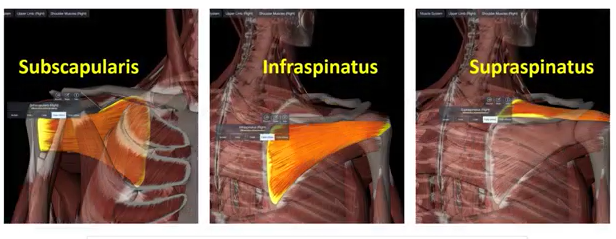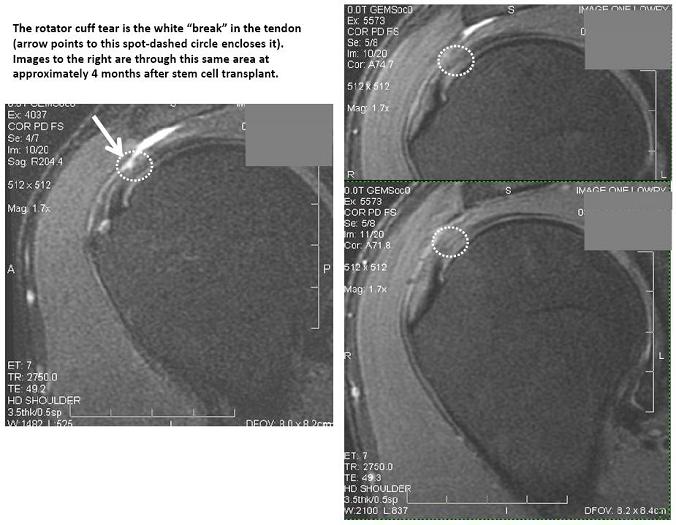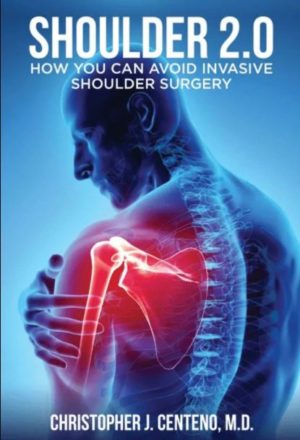Shoulder Pain
Shoulder pain can come in many different forms and be caused by many different issues. Many structures exist in a small area making it more difficult to accurately diagnose what is causing pain without spending appropriate time to diagnose the issue. Common causes of shoulder pain include shoulder arthritis, acromioclavicular (AC) joint sprain and arthritis, labral tears, shoulder bursa inflammation, shoulder impingement and rotator cuff damage.
Rotator Cuff
The Rotator Cuff is a group of 4 tendons that work together to move your shoulder in multiple directions by connecting your shoulder blade to the upper arm bone, the humerus. The rotator cuff tendons include the supraspinatus, infraspinatus, subscapularis, and teres minor (in the first column below).
| Muscle | Origin on scapula | Attachment on humerus | Function | Innervation |
| Supraspinatus muscle | supraspinous fossa | greater tubercle | abducts the arm | Suprascapular nerve (C5) |
| Infraspinatus muscle | infraspinous fossa | greater tubercle | laterally rotates the arm | Suprascapular nerve (C5-C6) |
| Teres minor muscle | lateral border | greater tubercle | laterally rotates the arm | Axillary nerve (C5) |
| Subscapularis muscle | subscapular fossa | lesser tubercle | medially rotates the humerus | Subscapular nerve (C5-C6) |
Each tendon causes the arm to move in a different direction in relation to the shoulder. The benefit of all these tendons controlling the shoulder is that, when used in concert, the shoulder can move in many directions.
Rotator Cuff Tendinopathy and Tears
Rotator cuff tendon damage (also known as tendinopathy or tears) can be caused by multiple issues. Research shows that tendon tears tend to more likely occur in tendons that are worn down, or, “tendinopathic” (1). I liken the rotator cuff tendons to a rope that has frayed with use over the years making it more likely to break with the next big tug. As the damage in the tendon builds up over the years, the rotator cuff is more likely to break with the next big tug.
Treatment Options
Rotator cuff surgery is typically done arthroscopically, or through a small camera, and allows the surgeon to attach the two ends of the torn tendon together. The surgeon is fixing the defect and therefore you are back to having an intact rotator cuff. The problem is the surgery often fails as it does not address the root cause of the tear in the first place. Research has shown that as we age, we not only have lower numbers of stem cells in our bone marrow but also more specifically in the area where the rotator cuff tendons attach to the main upper arm bone (2). This has been attributed to the poor healing rates and surprisingly high failure rates and re-tear rates of patients after surgery, especially older patients as surgery does not re-establish a normal bone to tendon connection (3). Rates of re-tear after surgical repair have been reported as greater than 55% (4).
Non-Surgical Treatment for Rotator Cuff Tears
Surgery is not the only answer and may not even be the best answer to the problem of a rotator cuff tear. A lot of our patients hear that a tendon is torn and immediately think that surgery is the only way to fix the issue. There is another way to address the pain and dysfunction of the shoulder as well as tackle the root-cause of the problem. Taking bone marrow stem cells from one area of the body and placing them at the point of damage in the rotator cuff is demonstrating promising results. Our study published back in February demonstrated excellent results in respect to patient function, pain improvement as well as MRI evidence of tear healing (5). This was all done without the use of a knife or inherent risks associated with surgery. Even better, the expected recovery time was around half of what surgery would have required.
In conclusion, there are many types of shoulder pain and many people suffer from rotator cuff issues. Even with a torn tendon, there is still an excellent chance that a regenerative treatment delivered under image guidance can help you heal and improve your pain and function without having to undergo rotator cuff tear surgery.
References:
- Cook, J L et al. “Revisiting the continuum model of tendon pathology: what is its merit in clinical practice and research?.” British journal of sports medicine vol. 50,19 (2016): 1187-91. doi:10.1136/bjsports-2015-095422
- Campbell, T Mark et al. “Tendon contains more stem cells than bone at the rotator cuff repair site.” Journal of shoulder and elbow surgery vol. 28,9 (2019): 1779-1787. doi:10.1016/j.jse.2019.02.008
- Bedeir, Yehia H et al. “Recurrent tears of the rotator cuff: Effect of repair technique and management options.” Orthopedic reviews vol. 10,2 7593. 4 Jul. 2018, doi:10.4081/or.2018.7593
- Shin, Yun Kyung et al. “Predictive Factors of Retear in Patients With Repaired Rotator Cuff Tear on Shoulder MRI.” AJR. American journal of roentgenology vol. 210,1 (2018): 134-141. doi:10.2214/AJR.17.17915
- Centeno, Christopher & Fausel, Zachary & Stemper, Ian & Azuike, Ugochi & Dodson, Ehren. (2020). A Randomized Controlled Trial of the Treatment of Rotator Cuff Tears with Bone Marrow Concentrate and Platelet Products Compared to Exercise Therapy: A Midterm Analysis. Stem Cells International. 2020. 1-10. 10.1155/2020/5962354.


